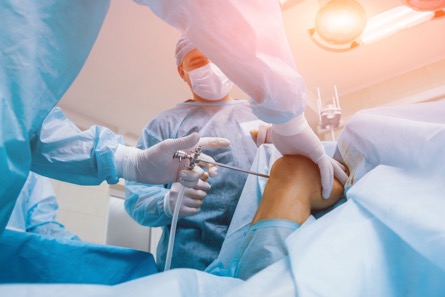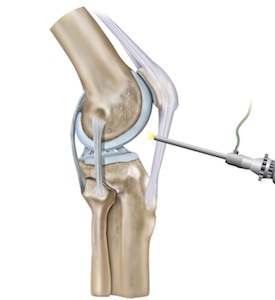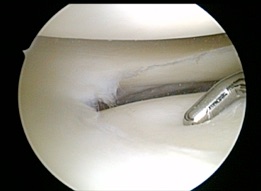Knee arthroscopy
This is a page about knee arthroscopy (keyhole surgery). It details what surgery entails what to expect afterwards, the costs and the recovery.

“I had a partial knee replacement at the Harbour hospital in December 2023. My surgeon Charles Willis-Owen was truly amazing! He made the whole process really straightforward and relatively painless! He was very supportive of I had any questions or issues. The nurses and physios were all very kind and caring.
Keyhole knee surgery
If you have got a pain in the knee after an injury, or coming on out of the blue, or you have been told by someone that you have a cartilage tear then you may well need a knee arthroscopy (keyhole surgery).
Knee arthroscopy is a technique I use to treat all sorts of problems inside the knee joint. The most common reason for having a knee arthroscopy is to trim or repair a torn meniscus (the rubbery ‘shock absorber’ cartilage inside the knee). Several other procedures can be done during arthroscopic surgery including tidying up worn out joint surfaces (articular cartilage damage), repairing defects in the articular cartilage, trimming the fat pad or abnormal plicae (folds of the joint lining that can cause pain) taking biopsies or removing loose pieces. Because several different things can be done in an arthroscopy patients’ experience of the surgery can vary.
Knee arthroscopy is performed through small cuts (keyhole) in your skin, using a special telescope (arthroscope) attached to a video camera. Compared with open surgery, arthroscopy has a much faster recovery time, less discomfort and a faster return to normal life.
The operation is done as a day case, usually under general anaesthesia. This means you will be asleep during the procedure. You will be asked to follow fasting instructions. This means not eating or drinking anything at all, typically for six hours beforehand.
Before the day of the surgery, I’ll discuss with you what will happen before, during and after your procedure, and your recovery. This is your opportunity to understand what will happen, and you can help yourself by preparing questions to ask about the risks, benefits and any alternatives to the procedure. This will help you to be informed, so you can give your consent for the procedure to go ahead, which you will be asked to do by signing a consent form which we usually post out when you book.

What happens during a knee arthroscopy?
An arthroscopy can take anything from 10 minutes to half an hour, depending on how much work is needed inside your knee joint. Once you are asleep, I’ll make two small incisions, one for the camera and one for the instruments. I will fill your joint with sterile saline to help produce a nice clear picture and to give me space to work. I’ll then pop in the camera and get to work!

When I’m in the knee I usually take some photos so you can see what the problem was, then I will I repair the damage or remove material that interferes with movement or causes pain in your knee and take a few more pictures afterwards.
Afterwards, I put in lots of numbing anaesthetics, then close the incisions with stitches. Waterproof dressings will be applied and a bandage will be wrapped around your knee. You will wake up comfortably and feel like you have had a short nap. The knee shouldn’t hurt too much, and usually, you will be able to get up and walk within the hour. It is rare to need crutches and this depends on what I need to do to fix you.
Book a consultationWhat to expect afterwards:
You’ll need to rest until the effects of the anaesthetic have passed. Take special care not to bump or knock the area. You will need pain relief to help with any discomfort as the anaesthetic wears off. You can usually go home when you feel ready, when you have managed to walk safely, have eaten without feeling sick and have passed water. This is usually an hour or two.
You will need to arrange for someone to drive you home. You should try to have a friend or relative stay with you for the first 24 hours, because of the anaesthetic.
You can take off your bandage at 48 hours, and throw it away. You must leave the waterproof dressings alone for 2 weeks. These are waterproof and you can shower with these on. They will be bloodstained and appear dirty but have been applied in a sterile environment, so it is best to leave these in place to minimise the risk of infection. If they get tatty or you don’t like the look of then we give you some spares to go on top, but don’t take the originals off without contacting me! A physiotherapist will see you before you go home and give you an exercise sheet for you to follow in the coming days.
“I had a partial knee replacement at the Harbour hospital in December 2023. My surgeon Charles Willis-Owen was truly amazing! He made the whole process really straightforward and relatively painless! He was very supportive of I had any questions or issues. The nurses and physios were all very kind and caring.
Recovering from knee arthroscopy
You will be provided with some painkillers to use after the operation. Anti-inflammatories such as Ibuprofen are also helpful. Only take them if you need to. Ice packs are very helpful for controlling pain and swelling for the first few days. You will be walking on the same day, and able to go up and down stairs. Your recovery time will depend on what treatment is performed on your knee joint. You should be able to resume your usual activities after six weeks depending on the severity of your knee problems and your level of fitness. Typically the knee is not at its best until 3 months or longer depending on what has been done.
General anaesthesia temporarily affects your co-ordination and reasoning skills, so you must not drive, drink alcohol, operate machinery or sign important documents for 24 hours afterwards. If you’re in any doubt about driving, contact your insurer so that you’re aware of their recommendations or restrictions. You shouldn’t drive until you’re confident that you could perform an emergency stop without discomfort. This is usually about one to three weeks after your operation. Continue with the exercises recommended by your physiotherapist, as they will help to improve your knee movement and strength.
What are the risks?
Knee arthroscopy is commonly performed and generally safe. However, to make an informed decision and give your consent, you need to be aware of the possible side-effects and the risk of complications of this procedure. Fortunately, these are all rare.
- Infection
- Bleeding
- Scars
- Blood Clots / DVT / PE
- Need for more surgery
- Failure to improve
- Rarely being worse off
I will discuss these with you before surgery. If you have any questions, just ask!
Frequently asked questions
Everyone is different, but you should usually be walking the same day, driving by about 10 days and good for quiet day-to-day life by 2 weeks. You won't be fully recovered until between 6 and 12 weeks though.
Yes, my team does lots and lots of knee arthroscopies every year. The three main differences are the waiting times, the fact that you don't get to choose your surgeon in the NHS, and where the surgery is done.
A lot of the knee arthroscopy in the NHS is done by junior doctors. Privately you will always be operated on by me.
No! Knee arthroscopy is not a treatment for arthritis and it has received bad press in the past when unscrupulous surgeons have offered this operation without any realistic prospect of it helping you. If there are other problems in the knee along with some arthritis then it may have a role (such as removing loose pieces).
If you have mild arthritis then injections are often the best bet. If you have severe arthritis then you probably need a knee replacement.